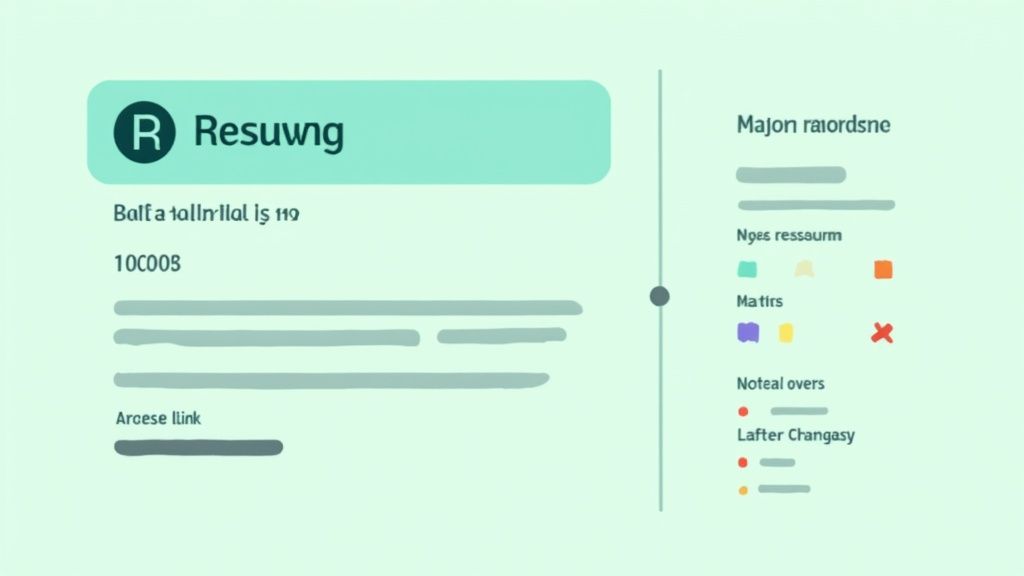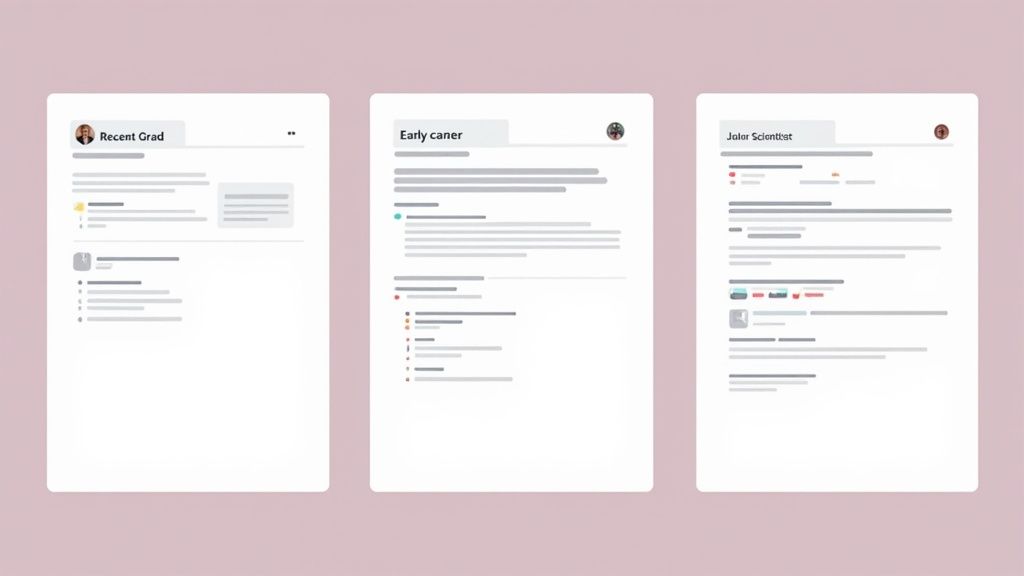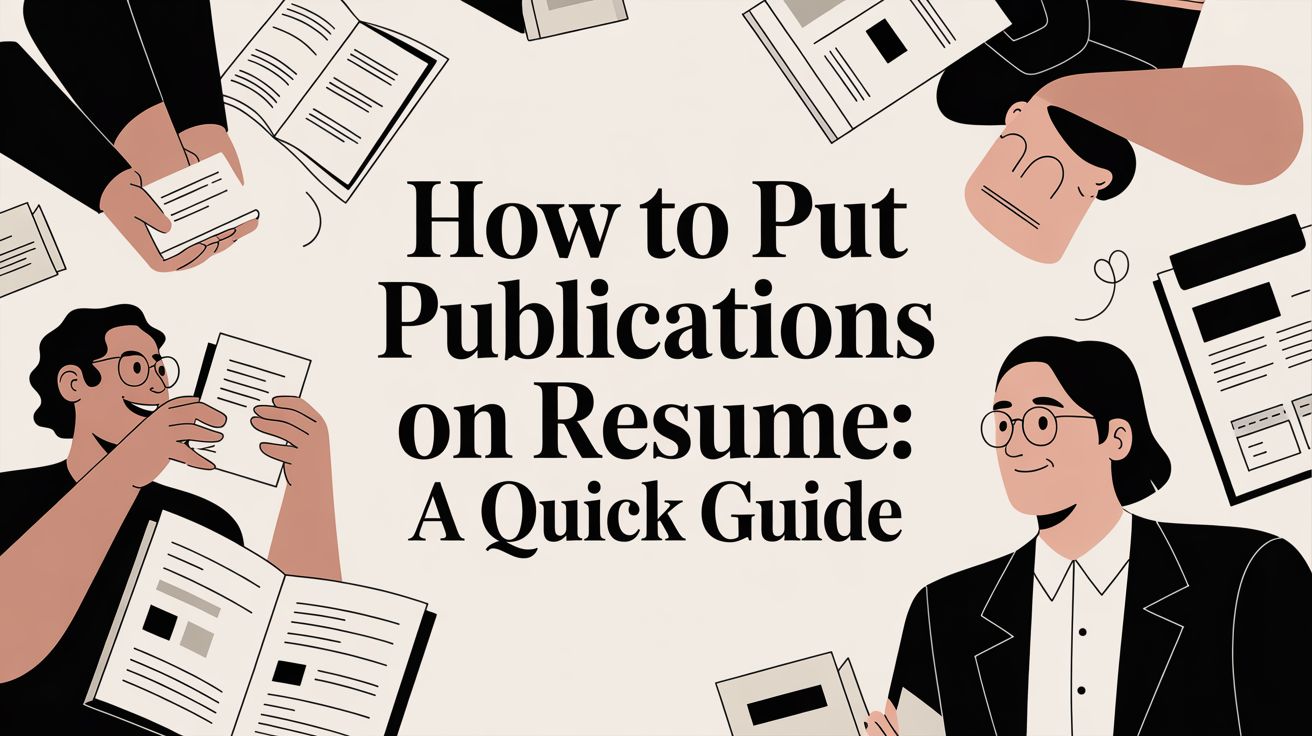To list publications on your resume, create a dedicated section, use a consistent citation style like APA, and list them in reverse chronological order. For data professionals, this is a strategic move that proves you can apply your skills to generate insights and get hired faster.
Should You Put Publications on a Data Science Resume?
Yes. In a competitive remote job market, publications are powerful proof of your expertise. They show you can perform complex data analysis and communicate your findings, contributing directly to the field.
Think of them as a peer reviewed project portfolio. Adding a publication transforms a claim like "proficient in Python and SQL" into a demonstrated ability to use those tools to uncover new insights. It adds a layer of credibility that a simple skills list cannot match.
Deciding to Include Publications
Whether you should include publications depends on your career stage and the specific data role you want. If you are a recent graduate, a published thesis can offset limited professional experience. For a seasoned data analyst, a white paper that improved an internal process can be just as impactful.
This visual guide can help you decide if listing publications is the right move for your situation.

The key takeaway is that relevant publications give your resume a serious boost for both academic and industry roles. The only thing that changes is what you include and where you put it.
Publication Inclusion Guide for Data Professionals
Here is a quick reference table to help you decide when and how to feature your work on a data focused resume.
Ultimately, this matrix is a guide. Always tailor your choices to the specific data job you are applying for, making sure every entry adds clear value.
A Strategic Advantage in a Competitive Field
Including publications is a smart way to stand out. Resume analytics reveal that over 52% of job seekers in technical fields list at least one publication. This trend shows that hiring managers are looking for people who do more than check boxes on a job description. For more on this, check out the latest resume trends from Resume Genius's research.
For a data professional, a well placed publication acts as a mini case study. It proves you can manage a project from data collection to final analysis and communicate the results. This is a critical skill for any remote or hybrid role.
Your resume is a marketing document designed to get you an interview. Publications provide concrete evidence of your skills that sets you apart. They help build a narrative of you as an expert, not just another candidate.
Where to Place Publications for Maximum Impact
Deciding where to list your publications is as important as deciding to list them. The right placement ensures your work gets noticed by recruiters and Applicant Tracking Systems (ATS) without cluttering your resume.
For data professionals, three strategies work best, each suited to different career stages and publication types.
The most direct approach is creating a dedicated "Publications" section". This is the perfect move if you have two or more significant works, like peer reviewed articles, conference papers, or major industry reports.
This section usually goes after your "Work Experience" or "Education," depending on what is more central to your career. It keeps your resume clean and lets a hiring manager quickly see the depth of your expertise.
Integrating Publications Into Your Experience
Another effective method is to weave a key publication directly into your "Experience" section". This strategy is a game changer when a publication was the direct result of a project you led.
Doing this connects your research skills to tangible business outcomes, which is exactly what hiring managers in industry roles want to see.
For instance, you could frame a bullet point under a previous role like this:
Authored a company white paper on the predictive model's performance, which was later published in the Journal of Data Analytics and highlighted a 15% reduction in customer churn.
This simple tweak transforms a citation into a powerful, quantifiable achievement. It shows not just what you published, but the real world impact it had.
Using an Additional Information Section
What about less formal pieces? Technical blog posts on Medium, a project write up on GitHub, or a presentation you gave at a local meetup are best placed in an "Additional Information" or "Projects" section".
While they are not formal publications, they still show your passion for the data field and prove you can communicate complex topics clearly. This placement signals that they are supplementary materials, so they do not dilute the impact of your core professional experience. It’s a great way for early career professionals to showcase their skills before they have formal, peer reviewed work.
The overall structure of your resume is key here. For more guidance, you can explore why a reverse chronological order is the best resume format to ensure your experience shines.
No matter which option you choose, consistency is everything. Use the same citation format for each entry and always prioritize relevance. The goal is to make your publications an asset that strengthens your story as a data professional, not a distraction.
Formatting Your Publications for ATS and Recruiters

How you format your publications section matters more than you might think. Your goal is a clean, scannable list that gets past both ATS software and human recruiters. A messy or inconsistent format is a fast way to get your resume ignored.
The key is to use a simplified citation style that is easy to read. You do not need to follow strict academic styles like full APA or MLA. What really matters is consistency and clarity.
The Anatomy of an ATS Friendly Publication Entry
Every entry in your publications section should have the same core elements. This consistency helps an ATS parse the information correctly and lets a recruiter quickly grasp your contributions. Your resume is not an academic paper, so a streamlined format is best.
Here are the essential components to include for each publication:
- Authors: List them out, but make sure to bold your name. This trick makes your contribution pop off the page.
- Year of Publication: Just the year in parentheses is perfect, like (2023).
- Title of Work: Use the full, official title of the article, paper, or report.
- Journal or Conference Name: Specify where it was published or presented. Italics work great for the journal or book title.
- Link (Optional but Recommended): A clickable DOI or URL gives hiring managers direct access to your work if they are curious.
The real secret here is simplicity. Recruiters spend only a few seconds on each resume. Your publication list should communicate expertise instantly, not force them to decode a complex academic citation.
A Quick Guide to Citation Styles
For data and analytics roles, the way you present your published work can make a real difference. The goal is readability, not academic perfection. The table below offers simple, effective templates for common publication types.
Citation Style Examples for Data & Analytics Resumes
This standardized approach ensures your resume gets past automated checks and is easy for a person to read. This is crucial, as many companies use ATS to screen candidates. Getting this right improves your odds significantly.
Do not forget that technical terms and keywords within your publication titles are gold for ATS screening. To optimize every part of your resume, check out our guide on why resume keywords for ATS matter more than ever. A well structured publications list does not just show your expertise; it helps you get seen.
Tailoring Your Publications to the Job Description

A generic list of your work will not impress a hiring manager. To make a real impact, you must connect your publications directly to the job you want. Think of this section like any other part of your resume. It needs to be sharp, relevant, and tailored.
First, analyze the job description. Look for specific technical skills, methodologies, or business problems they mention. Do they call out Python, machine learning, A/B testing, or data visualization with Tableau? Those are your guide.
Once you have your keywords, review your publications. Be selective. Choose only the ones that prove you have direct experience in those exact areas. A hiring manager for a data science role focused on NLP will care more about your paper on sentiment analysis than your research on supply chain optimization. Always choose relevance over volume.
Adding an Impact Statement
Here’s a powerful way to make your work stand out: add a brief, one sentence impact statement under each relevant publication. This simple step transforms a dry citation into a tangible business achievement, showing the hiring manager what you can do for them.
Think of it as a mini case study. It translates what you did in a lab or for a journal into a result that a business leader values.
Here’s what that looks like in practice:
- For a Data Scientist Role: Developed a Python based sentiment analysis model that improved customer feedback processing accuracy by 30%.
- For a BI Analyst Role: Created a series of Tableau dashboards for sales forecasting, which leadership adopted to guide quarterly planning.
- For a Machine Learning Engineer Role: Implemented a new machine learning algorithm that reduced model training time by 15% while maintaining predictive accuracy.
This small step is what separates a good publications section from a great one. It shows you understand the "so what" behind your work and can communicate its value in a business context, a critical skill for any remote data professional.
Handling Works in Progress
What if your most relevant work is not published yet? You should still include it. Listing submitted or in press publications shows you are actively contributing to your field. The key is to be transparent about their status.
Use simple, direct language to label them:
- (Submitted for Publication)
- (In Press)
- (Under Review)
This honesty builds trust and gives recruiters a look into your current projects. It proves your expertise is fresh. By tailoring each entry and adding crucial context, you show you are not just a researcher. You are a problem solver who understands what the company needs.
Real Resume Examples with Publication Sections
Theory is great, but seeing how this works is better. Let's walk through three different scenarios for data professionals, showing exactly how to position and format publications to make the right impression.
Each example is scannable, clear, and ATS friendly. You can build a resume just like these with Jobsolv’s free, ATS approved resume builder.
Example 1: The Recent Graduate
For anyone fresh out of a Master's program, a thesis is gold. It acts as a powerful stand in for professional experience, proving you can manage a complex, data driven project from start to finish.
Scenario: A recent Master of Data Science graduate is looking for their first remote Data Analyst role.
Placement: A dedicated "Publications & Research" section right below the "Education" section. This placement connects your academic achievements to your professional qualifications.
Resume Snippet:
Publications & Research
- Developed a predictive model in Python that achieved 92% accuracy in sales forecasting, using two years of historical transaction data.
Example 2: The Early Career Data Analyst
Once you have a few years of experience, showcase a mix of formal and informal publications. This signals that you are passionate about the field and committed to learning beyond your job.
Scenario: A Data Analyst with three years of experience is aiming for a Senior Analyst position at a remote first company.
Placement: This is a two part strategy. A high impact white paper is woven directly into the "Work Experience" section to show on the job initiative. Less formal pieces, like blog posts, are placed in an "Additional Information" section at the end.
Resume Snippet (Experience Section):
Data Analyst | Tech Solutions Inc. | 2021 – Present
- Authored an internal white paper, "Optimizing Customer Segmentation with K-Means Clustering," which led to a 10% improvement in targeted marketing campaign engagement.
Resume Snippet (Additional Information Section):
Technical Writing
- "A Practical Guide to A/B Testing with SQL," Towards Data Science on Medium, (2023)
- "Visualizing Geospatial Data in Tableau for Beginners," Personal Analytics Blog, (2022)
Example 3: The Senior Data Scientist
For seasoned professionals, the goal is precision, not volume. You want to highlight the high impact, peer reviewed work that cements your reputation as an expert.
Scenario: A Senior Data Scientist with eight years of experience is applying for a remote Machine Learning Lead role.
Placement: A clean, selective "Publications" section placed right after "Work Experience." It is prominent but does not overshadow your professional achievements.
Resume Snippet:
Selected Publications
- Chen, L., Davis, R., & Patel, M. (2022). "An Ensemble Method for Anomaly Detection in Financial Transactions." Journal of Machine Learning Research, 15(3).
- Davis, R., & Williams, J. (2020). "Scalable Natural Language Processing for Real-Time Sentiment Analysis." Proceedings of the International Conference on AI.
These examples provide a clear roadmap. It’s not just about listing your work; it’s about strategically presenting it to prove your value. You can find more structures like these in our collection of ATS friendly resume examples for data pros. Getting this right turns your achievements into your next opportunity.
Common Questions About Listing Publications

You’ve drafted your publications section, but a few questions might still remain. Getting these final details right is what separates a good resume from a great one. Let's clear up the most common uncertainties data professionals face.
The biggest question is always quantity. How many publications should you put on your resume? The simple answer is to always choose relevance over volume. Aim for three to five of your most powerful and relevant publications, the ones that directly echo the language in the job description.
A long list of everything you have ever written can overwhelm a recruiter. A shorter, curated selection that proves your skills in a specific area like machine learning or data visualization sends a much stronger signal.
What if a Publication Is Not Peer Reviewed?
This comes up often for data pros working in industry. The good news is that not every valuable publication has to come from a peer reviewed journal. Company white papers, technical blog posts, or slide decks from conference presentations are all fair game.
These types of publications can be incredibly valuable. They show you can communicate complex data concepts to different audiences, which is a critical skill in any analytics role. Just be sure to format them clearly and connect them to a real business outcome whenever possible.
Do Co-Authored Publications Count?
Absolutely. In today's world of remote and hybrid teams, showing you can collaborate effectively is a huge plus. Listing a co authored publication is a perfect way to do that.
When you list a piece you wrote with others, make one simple formatting tweak: bold your name in the list of authors. This tiny change makes your contribution pop, helping a busy recruiter see your role at a glance. It shows you can work with a team to produce high quality, data driven work.
Your publications section is not just a list of what you have done. It is a strategic tool to prove your current value. Every entry should have a clear purpose tied to the job you want now.
How Far Back Should You Go?
What about a paper you wrote a decade ago? As a general rule, it is best to stick to work from the last five to seven years. The data and analytics field moves quickly, so recent publications show that your skills are fresh and your knowledge is current.
Of course, there is an exception to every rule. If you have a foundational paper that is still highly cited or considered essential in its niche, you should absolutely include it, no matter how old it is. Think of that publication as a cornerstone of your professional reputation. It cements your status as a true expert.
Feeling confident about your resume is the first step toward landing your next remote data role. Jobsolv helps you take the next one by instantly tailoring your resume for any job description with its free ATS resume builder. Stop guessing what recruiters want to see and start applying with a resume optimized to get you hired.
.svg)















